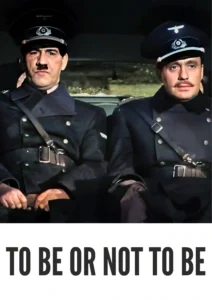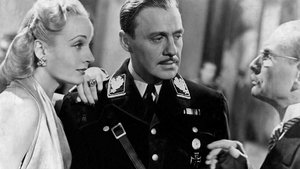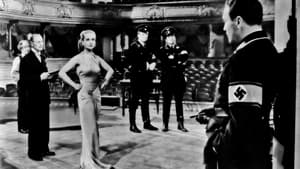Contact: [email protected]
Video Sources 0 Views
- Watch trailer
- To Be or Not to Be


Synopsis
Table of Contents
ToggleReview: To Be or Not to Be (1942) – A Classic Comedy of Errors

Introduction
To Be or Not to Be, released in 1942, is a comedic masterpiece directed by Ernst Lubitsch. Renowned for its sharp wit, clever satire, and impeccable performances, this classic film continues to delight audiences with its timeless humor and biting social commentary. In this review, we’ll explore the comedic genius of To Be or Not to Be and its enduring legacy in the world of cinema.
Check The Full Colorized Movies List
Check Our Colorized Movies Trailer Channel
Understanding To Be or Not to Be (1942): Director, Cast, and Genre
Directed by Ernst Lubitsch, To Be or Not to Be features a stellar cast led by Carole Lombard and Jack Benny. The film belongs to the comedy genre, known for its lighthearted humor, witty dialogue, and playful tone.
Exploring the World of To Be or Not to Be (1942): Plot and Characters
To Be or Not to Be follows the misadventures of a troupe of actors in Nazi-occupied Poland who become embroiled in a web of espionage and intrigue. As they attempt to outwit the enemy and save themselves from certain doom, they must rely on their quick thinking and comedic talents to stay one step ahead of danger. Along the way, they encounter a colorful cast of characters, including bumbling Nazis, cunning spies, and unsuspecting allies.
The Art of Film Colorization
While To Be or Not to Be was originally filmed in black and white, its early colorized version adds a new layer of visual splendor to its comedic hijinks. The colorization process enhances the film’s vibrant costumes and elaborate set designs, bringing the world of Nazi-occupied Poland to life with dazzling clarity.
Early Colored Films: A Brief History
The history of early colored films is marked by innovation and experimentation as filmmakers sought to enhance the visual appeal of their movies. From hand-tinted frames to pioneering technicolor processes, the evolution of colorization techniques transformed the cinematic landscape, offering audiences a new way to experience the laughter and excitement of classic comedies.
To Be or Not to Be (1942) and Its Early Colored Version
The decision to release To Be or Not to Be in a colorized format was made with the intention of immersing audiences in the vibrant world of Nazi-occupied Poland and enhancing the film’s visual appeal. While some purists may prefer the original black and white version, the early colorized edition of To Be or Not to Be adds a new layer of visual splendor to its comedic hijinks, bringing the humor and excitement of the story to life with dazzling clarity.
The Debate Over Film Colorization
The debate over film colorization continues to divide audiences and industry professionals alike. While some argue that colorization breathes new life into classic films and makes them more accessible to modern audiences, others maintain that it compromises the artistic integrity of the original work. As technology advances and filmmaking techniques evolve, the debate over colorization remains a topic of ongoing discussion within the film community.
Examining To Be or Not to Be (1942) as an Early Colored Film
Viewing To Be or Not to Be in its early colorized iteration offers audiences a fresh perspective on its comedic brilliance and visual splendor. The colorization process enhances the film’s vibrant costumes and elaborate set designs, bringing the world of Nazi-occupied Poland to life with dazzling clarity. As viewers are drawn into the zany antics of the troupe of actors, they are treated to a visual feast that immerses them in the laughter and excitement of classic comedy.
Influence and Legacy: To Be or Not to Be (1942)’s Impact on Cinema
To Be or Not to Be is widely regarded as a comedic masterpiece that continues to entertain and inspire audiences with its sharp wit and clever satire. Its timeless humor and biting social commentary have left an indelible mark on cinema, influencing generations of filmmakers and comedians alike.
Director’s Cinematic Legacy: Beyond To Be or Not to Be (1942)
Ernst Lubitsch’s directorial legacy extends far beyond To Be or Not to Be, encompassing a diverse body of work that includes acclaimed films such as Ninotchka and The Shop Around the Corner. As one of the most innovative filmmakers of his generation, Lubitsch was known for his ability to blend comedy with social commentary in a way that was both entertaining and thought-provoking. To Be or Not to Be stands as a testament to his talent and creativity, solidifying his reputation as one of the great auteurs of classic Hollywood cinema.
Themes Explored in To Be or Not to Be (1942)
At its core, To Be or Not to Be explores themes of deception, resilience, and the power of laughter in the face of adversity. Through its witty dialogue and clever satire, the film offers a humorous yet insightful commentary on the human condition, reminding viewers of the importance of finding joy and humor even in the darkest of times.
Reception and Controversy Surrounding To Be or Not to Be (1942)
Upon its release, To Be or Not to Be received widespread critical acclaim for its sharp wit, clever satire, and impeccable performances. While the decision to release the film in a colorized format sparked debate among purists, its enduring popularity has cemented its status as a comedic classic that continues to entertain and inspire audiences around the world.
Where to Watch To Be or Not to Be (1942) Online
For those eager to experience To Be or Not to Be for themselves, the film is readily available on popular streaming platforms such as Amazon Prime Video, Google Play Movies, and iTunes. Whether viewed in its original black and white format or its early colorized iteration, To Be or Not to Be offers a cinematic experience that is both timeless and visually stunning.
FAQs About To Be or Not to Be (1942)
1. Is To Be or Not to Be based on a true story?
No, To Be or Not to Be is a fictional comedy that satirizes the Nazi regime and the world of theater. While the film’s storyline may draw inspiration from real-life events, its characters and plot are works of fiction.
2. Who starred in To Be or Not to Be?
To Be or Not to Be stars Carole Lombard and Jack Benny in the lead roles, with supporting performances by Robert Stack, Felix Bressart, and Lionel Atwill. Lombard and Benny’s comedic chemistry and impeccable timing are highlights of the film, contributing to its enduring popularity.
3. What is the central message of To Be or Not to Be?
At its core, To Be or Not to Be explores the power of laughter and resilience in the face of tyranny and oppression. Through its witty dialogue and clever satire, the film offers a humorous yet insightful commentary on the human condition, reminding viewers of the importance of finding joy and humor even in the darkest of times.
4. Why was To Be or Not to Be released in a colorized format?
The decision to release To Be or Not to Be in a colorized format was made with the intention of immersing audiences in the vibrant world of Nazi-occupied Poland and enhancing the film’s visual appeal. While some purists may prefer the original black and white version, the early colorized edition of To Be or Not to Be adds a new layer of visual splendor to its comedic hijinks, bringing the humor and excitement of the story to life with dazzling clarity.
5. What is the legacy of To Be or Not to Be?
To Be or Not to Be is widely regarded as a comedic masterpiece that continues to entertain and inspire audiences with its sharp wit and clever satire. Its timeless humor and biting social commentary have left an indelible mark on cinema, influencing generations of filmmakers and comedians alike.
6. Are there any sequels or remakes of To Be or Not to Be?
No, there have been no official sequels or remakes of To Be or Not to Be. However, the film’s enduring popularity has inspired countless reinterpretations and homages in various media. Nonetheless, none have captured the sharp wit and comedic brilliance of the original 1942 classic.
7. Where can I watch To Be or Not to Be online?
For those eager to experience To Be or Not to Be for themselves, the film is readily available on popular streaming platforms such as Amazon Prime Video, Google Play Movies, and iTunes. Whether viewed in its original black and white format or its early colorized iteration, To Be or Not to Be offers a cinematic experience that is both timeless and visually stunning.
Conclusion
In conclusion, To Be or Not to Be (1942) stands as a comedic masterpiece that continues to entertain and inspire audiences with its sharp wit, clever satire, and timeless humor. Whether viewed in its original black and white format or its early colorized iteration, Ernst Lubitsch’s insightful direction and the impeccable performances of the cast offer a cinematic experience that is both delightful and thought-provoking. As viewers are drawn into the zany world of the troupe of actors, they are treated to a visual and comedic feast that reminds them of the power of laughter and resilience in the face of adversity. To Be or Not to Be remains a timeless classic that continues to bring joy and laughter to audiences around the world.















